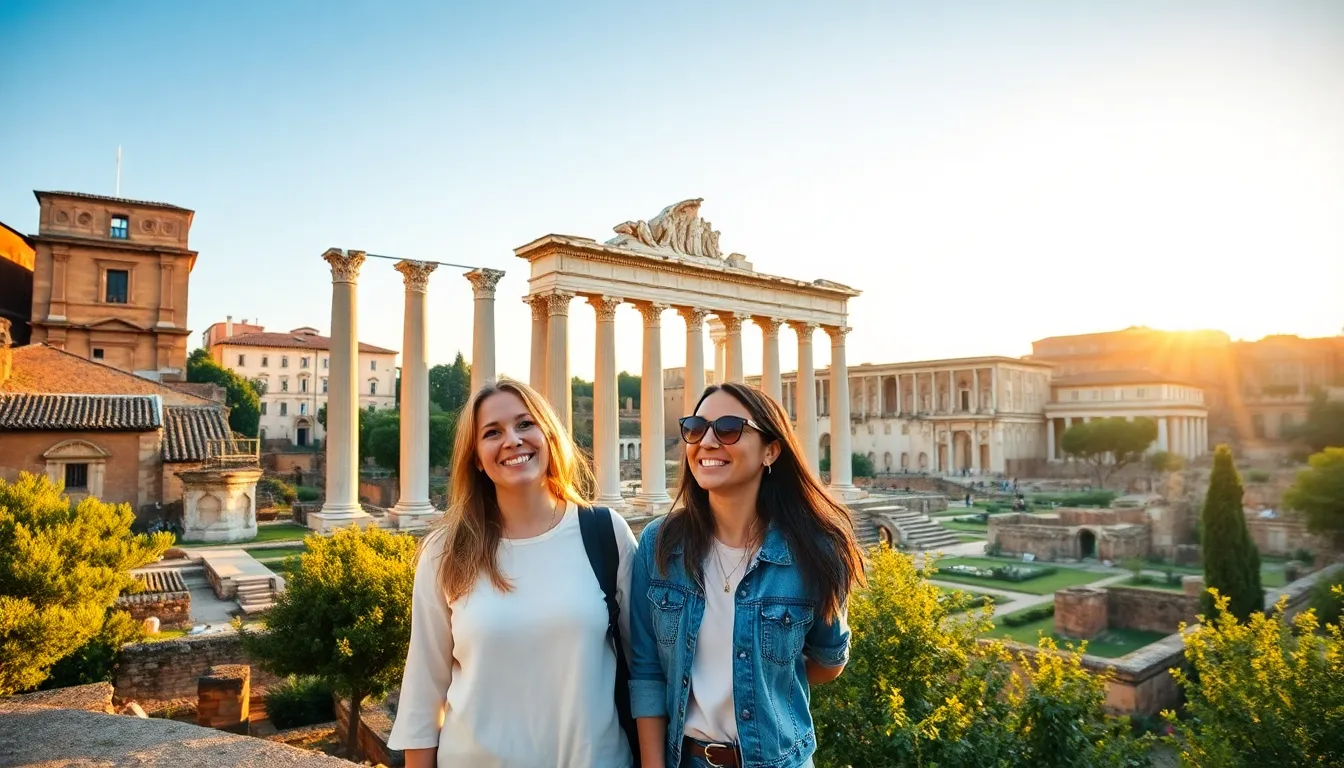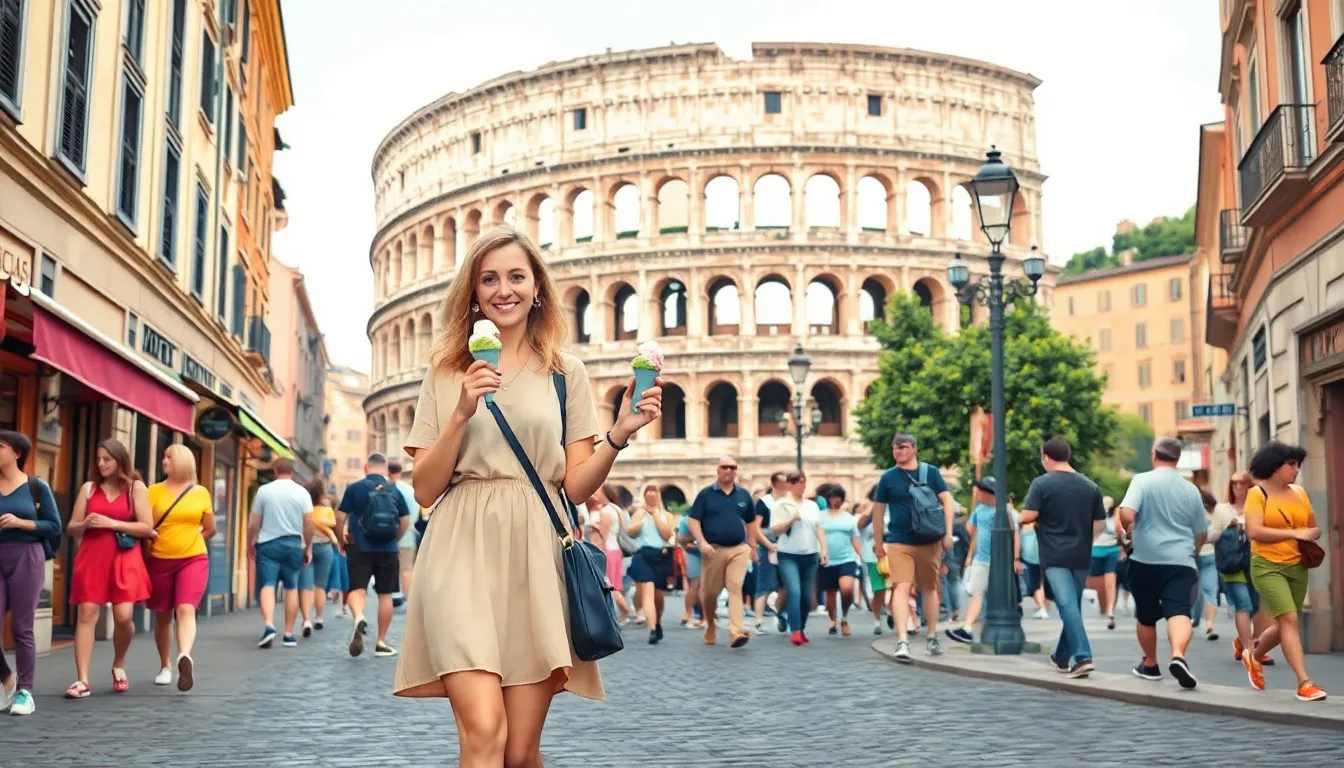Table of Contents
TogglePlanning a trip to Rome? Get ready to swap your daily grind for ancient ruins and mouthwatering pasta. But before you don that stylish sun hat and pack those cute sandals, there are a few savvy tips that’ll turn your Roman holiday from “eh” to “bellissimo!”
Essential Rome Travel Tips
Plan visits to major attractions early. Popular sites like the Colosseum and Vatican Museums often experience long lines. Purchasing tickets online saves time and ensures entry.
Wear comfortable shoes. Cobblestone streets can be challenging, and walking is the best way to explore the city. Many neighborhoods feature beautiful architecture and charming piazzas, easily accessible on foot.
Consider using public transportation. The Metro and bus systems offer efficient ways to travel around Rome. A Roma Pass provides access to public transport along with discounts on attractions.
Stay hydrated, especially during warm months. Carry a reusable water bottle and refill it at the numerous drinking fountains scattered throughout the city. The water is safe and refreshing.
Try local cuisine for an authentic experience. Pizza al taglio and gelato are must-tries. Dining in local trattorias often reveals hidden gems and delicious homemade dishes.
Learn basic Italian phrases. Locals appreciate attempts to communicate in their language. Simple greetings or polite requests can enhance interactions.
Visit neighborhoods at different times of the day. Early morning visits reward travelers with fewer crowds at popular sites. Evening strolls reveal a vibrant atmosphere filled with locals and stunning city lights.
Respect local customs, especially in religious sites. Dress modestly when visiting churches and follow any specific guidelines to show respect. Observing these practices enhances the overall experience.
These tips help travelers navigate Rome with ease. Enjoying the rich history and culture becomes effortless with proper planning and awareness.
Planning Your Trip to Rome

Planning a trip to Rome involves considering several key factors. Travelers benefit from knowing the best time to visit and how long to stay to maximize their experience.
Best Time to Visit
Spring and fall present the most favorable weather conditions in Rome. Temperatures from March to June and September to November remain mild, averaging between 60°F and 75°F. Major events, like Easter celebrations and the Rome Film Fest, draw crowds during these seasons. Visiting during winter months typically ensures fewer tourists, but temperatures can drop to 40°F. Summer, while vibrant, often brings heat and long lines at attractions. Choose times like late September or early October for a balance of good weather and manageable tourist levels.
How Long to Stay
A stay of four to five days allows travelers to explore key sites without rushing. Major attractions, including the Colosseum, Vatican City, and the Roman Forum, require sufficient time for thorough visits. Allocating time for neighborhoods like Trastevere or Testaccio enhances the experience of local culture. Travelers focused on art may consider a longer stay to appreciate museums fully. Day trips to nearby destinations, such as Tivoli or Ostia Antica, offer additional exploration opportunities. Balancing time among historic sites, culinary experiences, and shopping leads to a fulfilling visit.
Getting Around Rome
Navigating Rome presents exciting opportunities for travelers. Utilizing public transportation saves time while exploring the city.
Public Transportation Options
Buses, trams, and metro lines connect key areas in Rome efficiently. The ATAC network covers the city’s extensive public transport system, providing options like a single ticket priced at €1.50 valid for 100 minutes, including transfers. Tourists can purchase a Roma Pass, which offers unlimited travel for 48 or 72 hours, granting access to several museums. Trains also link to nearby cities, making day trips feasible. When planning routes, it’s essential to check schedules, especially for late-night travel since frequencies may decrease.
Walking and Biking Tips
Exploring Rome on foot reveals hidden gems and vibrant neighborhoods. Comfortable shoes make walking enjoyable on cobblestone streets. A bike rental offers another exciting way to explore, highlighting sights like the Colosseum and Vatican. Numerous bike-sharing programs exist, including electric bikes for easier navigation through hilly areas. Staying alert for traffic and adhering to bike lanes enhances safety. Visiting early in the morning or during weekdays minimizes crowds, allowing better experiences while taking in the city’s rich history.
Must-See Attractions
Rome boasts a rich tapestry of attractions that captivate visitors. Exploring ancient history and vibrant local culture enhances any travel experience.
Historical Sites
The Colosseum stands as an iconic symbol of Rome. This ancient amphitheater showcases the grandeur of Roman architecture and history. Visitors marvel at its intricate design and learn about gladiatorial battles. The Vatican City, home to St. Peter’s Basilica and the Sistine Chapel, ranks among the most important religious sites. Both of these draw enormous crowds. The Roman Forum provides insight into political and social life in ancient Rome. Walking through its ruins immerses visitors in a fascinating past. Each site tells a story that enriches the overall experience.
Local Experiences
Experiencing local cuisine transforms a trip to Rome. Sampling pizza al taglio, a traditional Roman-style pizza, provides a delicious insight into the city’s culinary heritage. Trying gelato from local vendors offers a refreshing treat on warm days. Taking leisurely strolls through neighborhoods like Trastevere reveals charming streets and vibrant markets. Engaging with locals fosters connections and offers a glimpse into everyday life. Participating in cooking classes allows travelers to learn the art of Italian cuisine while enjoying the company of others. Each local experience deepens appreciation for Rome’s culture and lifestyle.
Dining in Rome
Dining in Rome offers a rich variety of flavors and experiences. Discovering the local cuisine enhances any trip.
Traditional Roman Cuisine
Traditional Roman cuisine features simple, fresh ingredients. Dishes like pasta alla carbonara and cacio e pepe showcase classic flavors. Locals often enjoy pizza al taglio, which is pizza sold by the slice. Seasonal vegetables, such as artichokes, also play a significant role in local dishes. Sampling gelato from a renowned gelateria is essential, providing a refreshing treat on warm days. Exploring these flavors offers insights into the city’s culinary heritage.
Best Places to Eat
Rome boasts numerous trattorias and osterias, each presenting unique atmospheres. Trastevere is home to several traditional eateries that cater to both locals and tourists. La Pergola, a Michelin-starred restaurant, excels at fine dining and memorable experiences. For an authentic Roman experience, try Da Enzo al 29, known for its classic dishes and bustling ambiance. Eating at local markets, such as Mercato di Testaccio, allows exploration of street food favorites. Prioritizing these diverse dining experiences enriches any visit to Rome.
Safety Tips for Travelers
Travelers to Rome should prioritize their safety while exploring. Keeping valuables secure in bags, preferably with zippers, minimizes theft risks. Stick to busy areas where crowds gather, as tourists often attract pickpockets.
Avoid empty streets at night. Walking in well-lit areas and staying close to main roads enhances safety. Always remain aware of surroundings, especially when using mobile devices.
For transportation, use official taxi services or rideshare apps instead of accepting rides from unlicensed operators. Verify the driver’s identity through the app for added reassurance.
Learn emergency contact numbers, such as 112 for general emergencies and 113 for police assistance. Familiarity with local hospitals and authorities can provide peace of mind.
Be cautious when dining out. Select restaurants with good reviews to prevent scams. Understanding menu prices before ordering can help avoid unexpected costs.
Travelers should dress like locals to blend in. Unusual clothing or excessive jewelry might draw attention, which could lead to unwanted encounters.
Carry copies of important documents, such as passports and travel insurance, but keep originals secure. In case of loss, having copies streamlines the replacement process.
Utilizing hotel safes for keeping essential belongings safe can prevent theft. Always lock hotel room doors and use deadbolts when possible.
Review safety information from local tourism boards. Active awareness contributes to a secure and enjoyable experience in Rome.
Traveling to Rome can be an unforgettable adventure filled with history culture and delectable cuisine. By following the tips outlined in this guide travelers can navigate the city’s ancient streets and savor its culinary delights with ease.
Planning ahead is key to maximizing experiences at iconic sites while immersing oneself in local life enriches the journey further. Whether exploring vibrant neighborhoods or enjoying traditional dishes every moment in Rome offers a chance to create lasting memories.
With the right preparation and a spirit of adventure anyone can enjoy the magic of this timeless city. Embrace the journey and let Rome’s charm captivate the heart.




